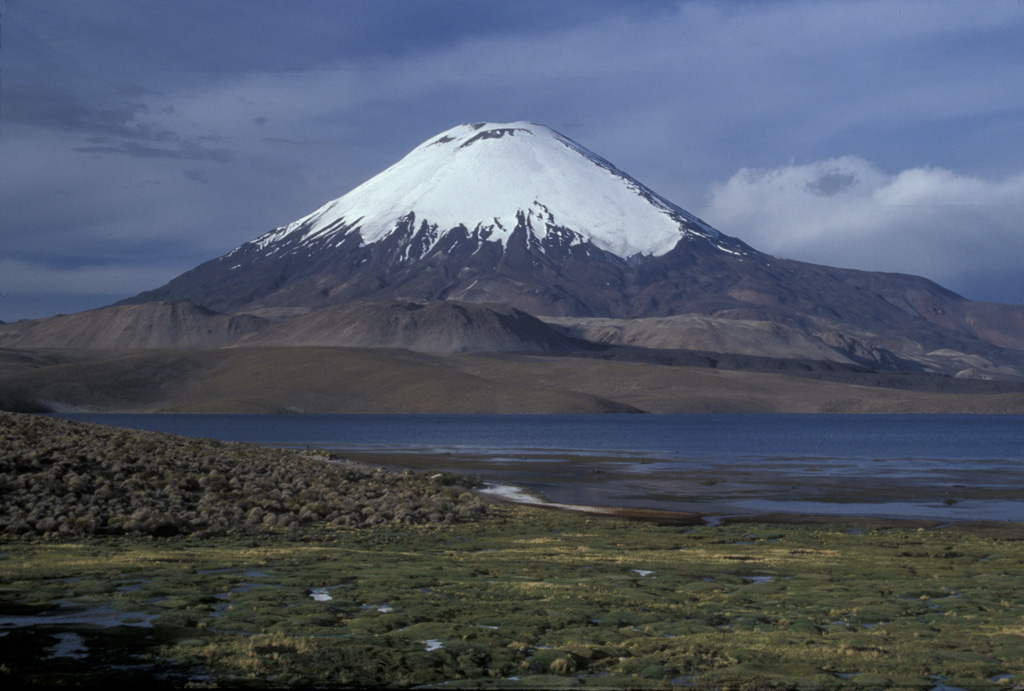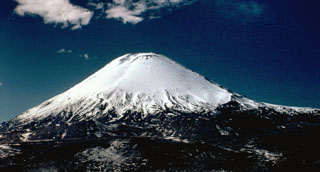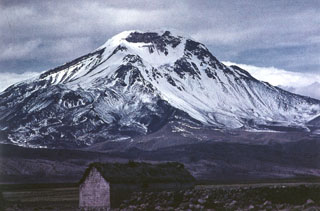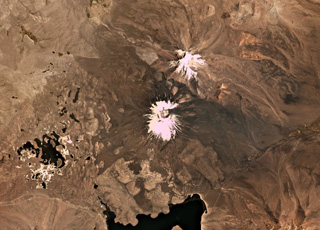

The Global Volcanism Program has no activity reports available for Parinacota.
The Global Volcanism Program has no Weekly Reports available for Parinacota.
The Global Volcanism Program has no Bulletin Reports available for Parinacota.
This compilation of synonyms and subsidiary features may not be comprehensive. Features are organized into four major categories: Cones, Craters, Domes, and Thermal Features. Synonyms of features appear indented below the primary name. In some cases additional feature type, elevation, or location details are provided.
Synonyms |
||||
| Payachata, Nevados de | ||||
Cones |
||||
| Feature Name | Feature Type | Elevation | Latitude | Longitude |
| Ajata, Volcanes de | Pyroclastic cone | 18° 11' 0" S | 69° 10' 0" W | |
| Parinacota | Stratovolcano | 6336 m | 18° 9' 57" S | 69° 8' 30" W |
| Pomerape | Stratovolcano | 6222 m | 18° 7' 0" S | 69° 7' 0" W |
|
|
||||||||||||||||||||||||||
There is data available for 6 confirmed Holocene eruptive periods.
0290 ± 300 years Confirmed Eruption VEI: 0
| Episode 1 | Eruption | Parinacota 3 edifice | |||||||||||||||||||
|---|---|---|---|---|---|---|---|---|---|---|---|---|---|---|---|---|---|---|---|---|
| 0290 ± 300 years - Unknown | Evidence from Isotopic: Cosmic Ray Exposure | |||||||||||||||||||
|
List of 2 Events for Episode 1 at Parinacota 3 edifice
| ||||||||||||||||||||
0090 ± 50 years Confirmed Eruption
| Episode 1 | Eruption | South flank (upper Volcanes de Ajata) | ||||||||||||||||||||||||
|---|---|---|---|---|---|---|---|---|---|---|---|---|---|---|---|---|---|---|---|---|---|---|---|---|---|
| 0090 ± 50 years - Unknown | Evidence from Correlation: Anthropology | ||||||||||||||||||||||||
|
List of 3 Events for Episode 1 at South flank (upper Volcanes de Ajata)
| |||||||||||||||||||||||||
1100 BCE ± 500 years Confirmed Eruption
| Episode 1 | Eruption | South flank (lower Volcanes de Ajata) | |||||||||||||||||||
|---|---|---|---|---|---|---|---|---|---|---|---|---|---|---|---|---|---|---|---|---|
| 1100 BCE ± 500 years - Unknown | Evidence from Isotopic: Cosmic Ray Exposure | |||||||||||||||||||
|
List of 2 Events for Episode 1 at South flank (lower Volcanes de Ajata)
| ||||||||||||||||||||
4320 BCE ± 1200 years Confirmed Eruption
| Episode 1 | Eruption | South flank (lower Volcanes de Ajata) | |||||||||||||||||||
|---|---|---|---|---|---|---|---|---|---|---|---|---|---|---|---|---|---|---|---|---|
| 4320 BCE ± 1200 years - Unknown | Evidence from Isotopic: Cosmic Ray Exposure | |||||||||||||||||||
|
List of 2 Events for Episode 1 at South flank (lower Volcanes de Ajata)
| ||||||||||||||||||||
5840 BCE ± 50 years Confirmed Eruption
| Episode 1 | Eruption | ||||||||||||||||||||||||||||||
|---|---|---|---|---|---|---|---|---|---|---|---|---|---|---|---|---|---|---|---|---|---|---|---|---|---|---|---|---|---|---|
| 5840 BCE ± 50 years - Unknown | Evidence from Isotopic: 14C (uncalibrated) | |||||||||||||||||||||||||||||
|
List of 4 Events for Episode 1
| ||||||||||||||||||||||||||||||
7950 BCE Confirmed Eruption
| Episode 1 | Eruption | Ajata | |||
|---|---|---|---|---|
| 7950 BCE - Unknown | Evidence from Isotopic: Ar/Ar | |||
There is no Deformation History data available for Parinacota.
There is no Emissions History data available for Parinacota.
 Symmetrical Volcán Parinacota rises north of Lake Chungará in the foreground. The lake was formed when collapse of an ancestral Parinacota edifice about 8000 years ago produced a massive 5-6 cu km debris avalanche that dammed a preexisting river. Subsequent eruptions of andesitic aa lava flows and andesitic pumice and scoria flows constructed the modern conical edifice, obscuring the avalanche source scarp. The summit of Parinacota volcano contains a pristine, 300-m-wide crater.
Symmetrical Volcán Parinacota rises north of Lake Chungará in the foreground. The lake was formed when collapse of an ancestral Parinacota edifice about 8000 years ago produced a massive 5-6 cu km debris avalanche that dammed a preexisting river. Subsequent eruptions of andesitic aa lava flows and andesitic pumice and scoria flows constructed the modern conical edifice, obscuring the avalanche source scarp. The summit of Parinacota volcano contains a pristine, 300-m-wide crater. The Nevados de Payachata volcanic group in northern Chile, seen here from the west, consists of the symmetrical, 6348-m-high Parinacota volcano (right) and its older twin volcano, Pleistocene 6222-m-high Pomerape volcano (left). The young cone of Parinacota post-dates collapse of an older edifice about 8000 years ago. The most recent activity at Parinacota produced a series of fresh-looking lava flows from satellitic cones on the south and SW flanks.
The Nevados de Payachata volcanic group in northern Chile, seen here from the west, consists of the symmetrical, 6348-m-high Parinacota volcano (right) and its older twin volcano, Pleistocene 6222-m-high Pomerape volcano (left). The young cone of Parinacota post-dates collapse of an older edifice about 8000 years ago. The most recent activity at Parinacota produced a series of fresh-looking lava flows from satellitic cones on the south and SW flanks.  Volcán Pomerape is the northernmost of twin stratovolcanoes forming the Nevados de Payachata along the Chile-Bolivia border. The 6282-m-high Pomerape lies across a saddle from Parinacota volcano, out of view to the right. The glacially dissected Pomerape was constructed above a base of dacitic-rhyolitic lava domes. The dominantly andesitic stratovolcano is capped by dacitic breccias and is of dominantly Pleistocene age.
Volcán Pomerape is the northernmost of twin stratovolcanoes forming the Nevados de Payachata along the Chile-Bolivia border. The 6282-m-high Pomerape lies across a saddle from Parinacota volcano, out of view to the right. The glacially dissected Pomerape was constructed above a base of dacitic-rhyolitic lava domes. The dominantly andesitic stratovolcano is capped by dacitic breccias and is of dominantly Pleistocene age. The southern side of conical, glacier-clad Parinacota volcano is seen from south of Laguna Changará, with its twin volcano, Pomerape, visible in the distance behind its right-hand flank. A complex of lighter colored dacitic-rhyolitic lava domes can be seen at the SW flank of Parinacota (middle left). The main cone of Parinacota was constructed during the Holocene primarily by the effusion of andesitic lava flows following collapse of an earlier edifice. The youngest of these flows was dated at between 1300 and 2000 years ago.
The southern side of conical, glacier-clad Parinacota volcano is seen from south of Laguna Changará, with its twin volcano, Pomerape, visible in the distance behind its right-hand flank. A complex of lighter colored dacitic-rhyolitic lava domes can be seen at the SW flank of Parinacota (middle left). The main cone of Parinacota was constructed during the Holocene primarily by the effusion of andesitic lava flows following collapse of an earlier edifice. The youngest of these flows was dated at between 1300 and 2000 years ago. A dark-colored andesitic volcanic bomb, ejected in a plastic state with a ballistic trajectory, drapes older rhyolitic rocks. The bomb was ejected during the Ajata volcanic eruptions. Helium surface-exposure ages ranging between about 1385 and 6500 years ago were obtained from the three lava flows erupted from the Volcanes de Ajata. Note the ice axe for scale (right-center).
A dark-colored andesitic volcanic bomb, ejected in a plastic state with a ballistic trajectory, drapes older rhyolitic rocks. The bomb was ejected during the Ajata volcanic eruptions. Helium surface-exposure ages ranging between about 1385 and 6500 years ago were obtained from the three lava flows erupted from the Volcanes de Ajata. Note the ice axe for scale (right-center). This viscous andesitic aa flow was erupted from the Volcanes de Ajata cinder cones along a N-S fracture on the southern flank of Parinacota. Helium-exposure ages of about 5985 and 6500 years ago were obtained from the lowermost and oldest of three lava flows of the Volcanes de Ajata. Snow-capped Acotango, Sajama, and Guallatiri volcanoes form the horizon to the east.
This viscous andesitic aa flow was erupted from the Volcanes de Ajata cinder cones along a N-S fracture on the southern flank of Parinacota. Helium-exposure ages of about 5985 and 6500 years ago were obtained from the lowermost and oldest of three lava flows of the Volcanes de Ajata. Snow-capped Acotango, Sajama, and Guallatiri volcanoes form the horizon to the east. The Nevados de Payachata volcanic group, the scenic highlight of Lauca National Park, is seen here from the SW and consists of the symmetrical, 6348-m-high Parinacota volcano (right) and its older twin volcano, Pleistocene 6222-m-high Pomerape volcano (left). Collapse of Parinacota about 8000 years ago produced a 6 cu km debris avalanche that formed the hummocky terrain in the foreground, with the colorful Llareta plant at the lower right. Hummocks in this medial portion of the avalanche deposit are about 50-100 m high.
The Nevados de Payachata volcanic group, the scenic highlight of Lauca National Park, is seen here from the SW and consists of the symmetrical, 6348-m-high Parinacota volcano (right) and its older twin volcano, Pleistocene 6222-m-high Pomerape volcano (left). Collapse of Parinacota about 8000 years ago produced a 6 cu km debris avalanche that formed the hummocky terrain in the foreground, with the colorful Llareta plant at the lower right. Hummocks in this medial portion of the avalanche deposit are about 50-100 m high. Glacier-clad Volcán Parinacota rises to the NE above Laguna Chungará near the Chile-Bolivia border. The lake was formed when collapse of Parinacota about 8000 years ago produced a 6 cu km debris avalanche that traveled 22 km to the west and blocked drainages. Subsequent eruptions constructed the 6348-m-high symmetrical stratovolcano, which towers above late-Pleistocene andesitic-to-rhyolitic lava domes and flows in the middle ground.
Glacier-clad Volcán Parinacota rises to the NE above Laguna Chungará near the Chile-Bolivia border. The lake was formed when collapse of Parinacota about 8000 years ago produced a 6 cu km debris avalanche that traveled 22 km to the west and blocked drainages. Subsequent eruptions constructed the 6348-m-high symmetrical stratovolcano, which towers above late-Pleistocene andesitic-to-rhyolitic lava domes and flows in the middle ground.  The two snow-capped volcanoes of the Nevados de Payachata volcanic group dominate this NASA International Space Station image (with north to the bottom). A prominent summit crater tops symmetrical Parinacota volcano, constructed to the SW of its eroded Pleistocene twin, Pomerape volcano. Silicic lava flows from Parinacota form lobes extending into Laguna Chungará, which was formed when a major debris avalanche from Parinacota blocked drainages. The hummocky debris-avalanche deposit covers much of the lower right part of the image.
The two snow-capped volcanoes of the Nevados de Payachata volcanic group dominate this NASA International Space Station image (with north to the bottom). A prominent summit crater tops symmetrical Parinacota volcano, constructed to the SW of its eroded Pleistocene twin, Pomerape volcano. Silicic lava flows from Parinacota form lobes extending into Laguna Chungará, which was formed when a major debris avalanche from Parinacota blocked drainages. The hummocky debris-avalanche deposit covers much of the lower right part of the image. Snow capped volcanoes dot this NASA International Space Station image (with north to the upper right) taken along the Chile-Bolivia border. The snow-capped peak at the far left-center is Guallatiri volcano, and to its right are the three peaks of Nevados Quimsachata, which includes Acotango volcano. The two peaks at the upper left are Pomerape and Parinacota, with Laguna Chungara below. Nevado del Sajama in Bolivia lies at the upper right-center. At the lower right is the snow-free volcano of Macizo de Larancagua.
Snow capped volcanoes dot this NASA International Space Station image (with north to the upper right) taken along the Chile-Bolivia border. The snow-capped peak at the far left-center is Guallatiri volcano, and to its right are the three peaks of Nevados Quimsachata, which includes Acotango volcano. The two peaks at the upper left are Pomerape and Parinacota, with Laguna Chungara below. Nevado del Sajama in Bolivia lies at the upper right-center. At the lower right is the snow-free volcano of Macizo de Larancagua. Parinacota is the larger of the two main edifices in this November 2019 Planet Labs satellite image monthly mosaic (N is at the top; this image is approximately 23 km across). With Pomerape to the NE, together they form the Nevados de Payachata group along the Chile-Bolivia border. The group of lakes to the SW formed within a debris avalanche deposit about 8,000 years ago that is more than 22 km long with a volume of 6 km3. The current cone formed over the resulting scarp and older edifice, and has a summit crater around 650 m wide. Lava flows are visible on all flanks, with some flows emplaced around the debris avalanche deposit hummocks.
Parinacota is the larger of the two main edifices in this November 2019 Planet Labs satellite image monthly mosaic (N is at the top; this image is approximately 23 km across). With Pomerape to the NE, together they form the Nevados de Payachata group along the Chile-Bolivia border. The group of lakes to the SW formed within a debris avalanche deposit about 8,000 years ago that is more than 22 km long with a volume of 6 km3. The current cone formed over the resulting scarp and older edifice, and has a summit crater around 650 m wide. Lava flows are visible on all flanks, with some flows emplaced around the debris avalanche deposit hummocks.Maps are not currently available due to technical issues.
There are no samples for Parinacota in the Smithsonian's NMNH Department of Mineral Sciences Rock and Ore collection.
| Copernicus Browser | The Copernicus Browser replaced the Sentinel Hub Playground browser in 2023, to provide access to Earth observation archives from the Copernicus Data Space Ecosystem, the main distribution platform for data from the EU Copernicus missions. |
| MIROVA | Middle InfraRed Observation of Volcanic Activity (MIROVA) is a near real time volcanic hot-spot detection system based on the analysis of MODIS (Moderate Resolution Imaging Spectroradiometer) data. In particular, MIROVA uses the Middle InfraRed Radiation (MIR), measured over target volcanoes, in order to detect, locate and measure the heat radiation sourced from volcanic activity. |
| MODVOLC Thermal Alerts | Using infrared satellite Moderate Resolution Imaging Spectroradiometer (MODIS) data, scientists at the Hawai'i Institute of Geophysics and Planetology, University of Hawai'i, developed an automated system called MODVOLC to map thermal hot-spots in near real time. For each MODIS image, the algorithm automatically scans each 1 km pixel within it to check for high-temperature hot-spots. When one is found the date, time, location, and intensity are recorded. MODIS looks at every square km of the Earth every 48 hours, once during the day and once during the night, and the presence of two MODIS sensors in space allows at least four hot-spot observations every two days. Each day updated global maps are compiled to display the locations of all hot spots detected in the previous 24 hours. There is a drop-down list with volcano names which allow users to 'zoom-in' and examine the distribution of hot-spots at a variety of spatial scales. |
|
WOVOdat
Single Volcano View Temporal Evolution of Unrest Side by Side Volcanoes |
WOVOdat is a database of volcanic unrest; instrumentally and visually recorded changes in seismicity, ground deformation, gas emission, and other parameters from their normal baselines. It is sponsored by the World Organization of Volcano Observatories (WOVO) and presently hosted at the Earth Observatory of Singapore.
GVMID Data on Volcano Monitoring Infrastructure The Global Volcano Monitoring Infrastructure Database GVMID, is aimed at documenting and improving capabilities of volcano monitoring from the ground and space. GVMID should provide a snapshot and baseline view of the techniques and instrumentation that are in place at various volcanoes, which can be use by volcano observatories as reference to setup new monitoring system or improving networks at a specific volcano. These data will allow identification of what monitoring gaps exist, which can be then targeted by remote sensing infrastructure and future instrument deployments. |
| Volcanic Hazard Maps | The IAVCEI Commission on Volcanic Hazards and Risk has a Volcanic Hazard Maps database designed to serve as a resource for hazard mappers (or other interested parties) to explore how common issues in hazard map development have been addressed at different volcanoes, in different countries, for different hazards, and for different intended audiences. In addition to the comprehensive, searchable Volcanic Hazard Maps Database, this website contains information about diversity of volcanic hazard maps, illustrated using examples from the database. This site is for educational purposes related to volcanic hazard maps. Hazard maps found on this website should not be used for emergency purposes. For the most recent, official hazard map for a particular volcano, please seek out the proper institutional authorities on the matter. |
| IRIS seismic stations/networks | Incorporated Research Institutions for Seismology (IRIS) Data Services map showing the location of seismic stations from all available networks (permanent or temporary) within a radius of 0.18° (about 20 km at mid-latitudes) from the given location of Parinacota. Users can customize a variety of filters and options in the left panel. Note that if there are no stations are known the map will default to show the entire world with a "No data matched request" error notice. |
| UNAVCO GPS/GNSS stations | Geodetic Data Services map from UNAVCO showing the location of GPS/GNSS stations from all available networks (permanent or temporary) within a radius of 20 km from the given location of Parinacota. Users can customize the data search based on station or network names, location, and time window. Requires Adobe Flash Player. |
| DECADE Data | The DECADE portal, still in the developmental stage, serves as an example of the proposed interoperability between The Smithsonian Institution's Global Volcanism Program, the Mapping Gas Emissions (MaGa) Database, and the EarthChem Geochemical Portal. The Deep Earth Carbon Degassing (DECADE) initiative seeks to use new and established technologies to determine accurate global fluxes of volcanic CO2 to the atmosphere, but installing CO2 monitoring networks on 20 of the world's 150 most actively degassing volcanoes. The group uses related laboratory-based studies (direct gas sampling and analysis, melt inclusions) to provide new data for direct degassing of deep earth carbon to the atmosphere. |
| Large Eruptions of Parinacota | Information about large Quaternary eruptions (VEI >= 4) is cataloged in the Large Magnitude Explosive Volcanic Eruptions (LaMEVE) database of the Volcano Global Risk Identification and Analysis Project (VOGRIPA). |
| EarthChem | EarthChem develops and maintains databases, software, and services that support the preservation, discovery, access and analysis of geochemical data, and facilitate their integration with the broad array of other available earth science parameters. EarthChem is operated by a joint team of disciplinary scientists, data scientists, data managers and information technology developers who are part of the NSF-funded data facility Integrated Earth Data Applications (IEDA). IEDA is a collaborative effort of EarthChem and the Marine Geoscience Data System (MGDS). |